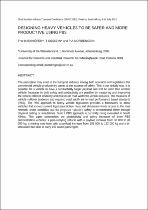JavaScript is disabled for your browser. Some features of this site may not work without it.
- ResearchSpace
- →
- Research Publications/Outputs
- →
- Conference Publications
- →
- View Item
| dc.contributor.author |
Kienhöfer, FW

|
|
| dc.contributor.author |
Dessein, T

|
|
| dc.contributor.author |
Nordengen, Paul A

|
|
| dc.date.accessioned | 2013-08-05T07:52:19Z | |
| dc.date.available | 2013-08-05T07:52:19Z | |
| dc.date.issued | 2013-07 | |
| dc.identifier.citation | Kienhöfer, F.W., Dessein, T. and Nordengen, P.A. 2013. Designing heavy vehicles to be safer and more productive using PBS. In: 32nd Southern African Transport Conference (SATC 2013), Pretoria, South Africa, 8-11 July 2013 | en_US |
| dc.identifier.uri | http://hdl.handle.net/10204/6919 | |
| dc.description | 32nd Southern African Transport Conference (SATC 2013), Pretoria, South Africa, 8-11 July 2013 | en_US |
| dc.description.abstract | The perception may exist in the transport industry among both operators and legislators that commercial vehicle productivity comes at the expense of safety. This is not strictly true. It is possible for a vehicle to have a substantially larger payload and still be safer than another vehicle. Increases in both safety and productivity are possible by measuring and improving the vehicle rollover tendency and how much road width the vehicle requires. The measures of vehicle rollover tendency and required road width are termed performance based standards (PBS). The PBS approach to heavy vehicle legislation provides a framework to allow vehicles that exceed current legal prescriptive mass and dimension limits access to the road network, under condition that the proposed vehicle’s safety is demonstrated either through physical testing or simulations. Such a PBS approach is currently being evaluated in South Africa. This paper summarises the productivity and safety increases of three PBS demonstration vehicles: a pipe-carrying vehicle with a payload increase from 32 000 to 48 000 kg, a mining road train with a payload increase from 105 000 to 122 000 kg and a bi-articulated bus able to carry 137 seated passengers. | en_US |
| dc.language.iso | en | en_US |
| dc.publisher | South African Transport Conference | en_US |
| dc.relation.ispartofseries | Workflow;11318 | |
| dc.subject | Commercial vehicle productivity | en_US |
| dc.subject | Performance based standards | en_US |
| dc.subject | PBS | en_US |
| dc.subject | Heavy vehicle legislation | en_US |
| dc.subject | Legal prescriptive mass | en_US |
| dc.subject | Physical testing | en_US |
| dc.subject | Pipe-carrying vehicle | en_US |
| dc.subject | Mining road train | en_US |
| dc.title | Designing heavy vehicles to be safer and more productive using PBS | en_US |
| dc.type | Conference Presentation | en_US |
| dc.identifier.apacitation | Kienhöfer, F., Dessein, T., & Nordengen, P. A. (2013). Designing heavy vehicles to be safer and more productive using PBS. South African Transport Conference. http://hdl.handle.net/10204/6919 | en_ZA |
| dc.identifier.chicagocitation | Kienhöfer, FW, T Dessein, and Paul A Nordengen. "Designing heavy vehicles to be safer and more productive using PBS." (2013): http://hdl.handle.net/10204/6919 | en_ZA |
| dc.identifier.vancouvercitation | Kienhöfer F, Dessein T, Nordengen PA, Designing heavy vehicles to be safer and more productive using PBS; South African Transport Conference; 2013. http://hdl.handle.net/10204/6919 . | en_ZA |
| dc.identifier.ris | TY - Conference Presentation AU - Kienhöfer, FW AU - Dessein, T AU - Nordengen, Paul A AB - The perception may exist in the transport industry among both operators and legislators that commercial vehicle productivity comes at the expense of safety. This is not strictly true. It is possible for a vehicle to have a substantially larger payload and still be safer than another vehicle. Increases in both safety and productivity are possible by measuring and improving the vehicle rollover tendency and how much road width the vehicle requires. The measures of vehicle rollover tendency and required road width are termed performance based standards (PBS). The PBS approach to heavy vehicle legislation provides a framework to allow vehicles that exceed current legal prescriptive mass and dimension limits access to the road network, under condition that the proposed vehicle’s safety is demonstrated either through physical testing or simulations. Such a PBS approach is currently being evaluated in South Africa. This paper summarises the productivity and safety increases of three PBS demonstration vehicles: a pipe-carrying vehicle with a payload increase from 32 000 to 48 000 kg, a mining road train with a payload increase from 105 000 to 122 000 kg and a bi-articulated bus able to carry 137 seated passengers. DA - 2013-07 DB - ResearchSpace DP - CSIR KW - Commercial vehicle productivity KW - Performance based standards KW - PBS KW - Heavy vehicle legislation KW - Legal prescriptive mass KW - Physical testing KW - Pipe-carrying vehicle KW - Mining road train LK - https://researchspace.csir.co.za PY - 2013 T1 - Designing heavy vehicles to be safer and more productive using PBS TI - Designing heavy vehicles to be safer and more productive using PBS UR - http://hdl.handle.net/10204/6919 ER - | en_ZA |






